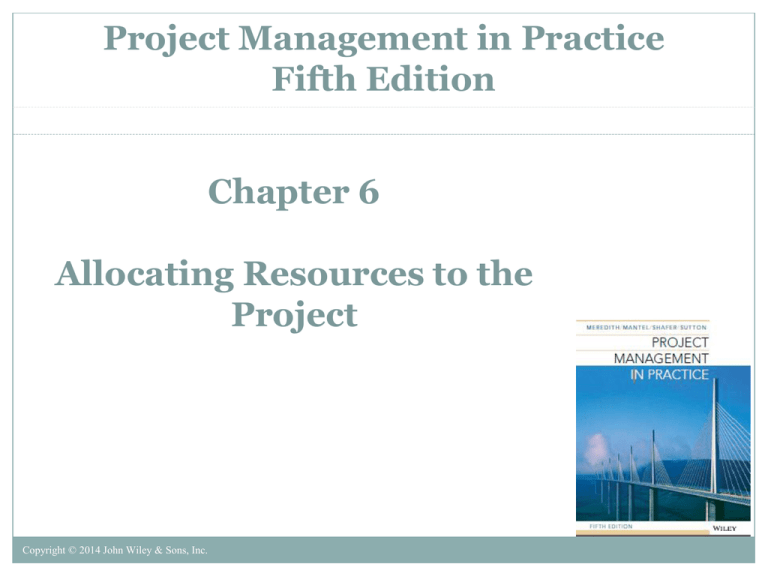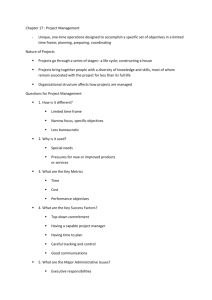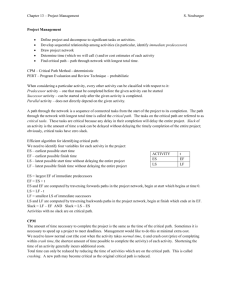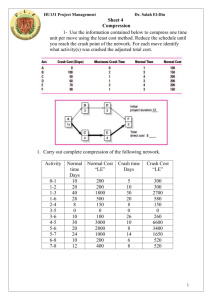
Project Management in Practice
Fifth Edition
Chapter 6
Allocating Resources to the
Project
Copyright © 2014 John Wiley & Sons, Inc.
Introduction
•
Projects compete with each other for resources
1. If resource is used but not consumed, which project
must wait to use resource
2. If resource is consumed during use, may not be
available for other projects or other projects must
wait for replacement
•
In either case, one project must wait
–
•
•
One project is delayed
Likewise, different activities on the same project
may compete for resources
Trade-offs must be made
6-2
Expediting a Project (Assumptions)
1. Smaller problem to avoid unnecessary
arithmetic
2. Problem set in a deterministic world
3. All estimates of task duration are based on
normal (or standard) resource loadings
6-3
Expediting a Project (Approaches)
1. The critical path method
2. Fast-tracking a project
3. Project expediting in practice
1. Opportunities before the project begins
2. Opportunities when the project is underway
6-4
The Critical Path Method
•
•
•
•
•
Normal duration estimates
Normal costs
Crash duration estimates
Crash costs
Crash cost per day
6-5
Notes on Crashing
• Important to make sure the resources required to
crash the project are available
• Technology may be used to crash an activity
– Using Ditch Witch to dig a ditch rather than adding
more workers
• May have to expedite tasks not on critical path to
make resources available to other projects
• Some tasks cannot be crashed
6-6
How to Crash
•
•
Start with the normal schedule
Select activities to crash, one at a time
1. Focus on the critical path(s)
2. Select least expensive activity to crash
•
Calculate slope information on activities
to crash
crash cost - normal cost
slope
crash time - normal time
6-7
An Example of a Normal/Crash
Project
Table 6-1
6-8
A PERT/CPM Example of Crashing
a Project, AOA Network Part 1
Figure 6-1 (Partial)
6-9
A PERT/CPM Example of Crashing
a Project, AOA Network Part 2
Figure 6-1 (Partial)
6-10
CPM Crash Cost-Duration History
Figure 6-2
6-11
Fast-Tracking a Project
• An expediting technique in which one phase
of the project is started before preceding
phases are completed
• Used in the construction industry when the
building phase is started before the design
and planning phases are complete
• This technique is particularly appropriate
when large proportion of work is routine
6-12
Project Expediting in Practice
1. Project manager may know ahead of time
that this project is time-critical and needs
to be finished as early as possible
2. Project manager may during project that it
needs to be finished earlier
3. Something delays the project and time
needs to be made up
6-13
Opportunities Before the Project
Begins
• Most projects have one time estimate
• Many projects have a project “buffer”
• A project time contingency may be added as
well
• Can monitor key activities closely
• May order long-lead time items early
6-14
Opportunities When the Project Is
Underway
•
•
•
•
•
•
•
•
•
•
•
•
Focus on critical path
Use contingency time
Pull resources from less critical activities
Move buffers to more critical activities
May skip less critical steps
May postpone activities involving non-core members
Move activities to post-project phase
May run activities in parallel or use weekends
Pressuring team to work faster
Get additional resources for overtime or more people
May reduce scope
May wait and see
6-15
Resource Loading
• Refers to the amounts of specific resources
that are scheduled for use on specific
activities or projects at specific time
• It is usually presented in the form of a list or
table
• Will see using short documentary DVD
example
6-16
Project Plan and Gantt Chart for
Production of a Short Documentary Film
Figure 6-3
6-17
Gantt Chart for DVD Project,
Adjusted for Client Availability
Figure 6-4
6-18
Resource Loading Chart for
DVD Production
Table 6-3
6-19
Resource Loading Issues
• Most project management software assumes
that any resource assigned to an activity will
work on that activity 100 percent of the
time available
– Can be resolved by allocating a specific
percentage of time to project
• It is easy to over utilize human resources
– Overtime is expensive
6-20
Resource Leveling
• To perform resource leveling, software will move
activities so that resources do not exceed their
capacity
– Using available slack first
– Extending project duration where using slack does not
work
• Project manager may not try to level all resources
• A working schedule may require more resources
• A more-or-less steady state demand for human
resources is highly desirable
6-21
Resource Over Allocation Report for
Scriptwriter Showing All Activities
Figure 6-5
6-22
Graphic Resource Over Allocation
Report for Scriptwriter
Figure 6-6
6-23
Resource Leveled Report for
Scriptwriter Showing All Activities
Figure 6-7
6-24
Graphic Resource Leveled Report
for Scriptwriter
Figure 6-8
6-25
Daily Resource Loading Chart
for Scriptwriter Leveled
Table 6-4
6-26
Final Gantt Chart Schedule,
Scriptwriters and Producer Leveled
Figure 6-9
6-27
Resource Loading/Leveling and
Uncertainty
• Holidays, vacations, sick days can reduce
human resource availability
• Not all required facilities and equipment
will be available when needed
• There may be change orders
• All of these must be factored into plans
6-28
Allocating Scarce Resources to
Projects
• Leveling resources using slack is often not
possible
• Software needs instructions about what priority to
use when allocating scare resources
• When demand exceeds supply, software assigns a
resource according to some priority rule selected
by project manager
• The key problem is deciding which activities gets
the scare resource and in what order
6-29
Some Priority Rules
•
•
•
•
•
•
•
As soon as possible
As late as possible
Shortest task duration first
Minimum slack first
Most critical followers
Most successors
Most resources first
6-30
Allocating Scare Resources to
Several Projects
• When the allocating scarce resources is extended
to where several projects are being carried out
concurrently, the size and complexity of the
problem increase
• However, the nature of the underlying problem
remains the same
• There is a decided advantage if several projects
are joined as a set
• With several projects, we can link them together
with pseudoactivities
6-31
Pseudoactivities
• Pseudoactivities are those which have duration but
require no resources
• The use of pseudoactivities allows a set of projects
to be linked and dealt with as though it were a
single project
– The individual projects are interrelated by specifying
predecessor/successor relationships in Microsoft
Project
– They appear to Project to be parts of one project
• Allows use of Microsoft Project resource loading
and leveling charts and tables
6-32
Multiple Projects Connected with
Pseudoactivities
Figure 6-11
6-33
Criteria of Priority Rules
• Project manager faces the problem of choosing between
different outcomes that result from different priority rules
• Must also deal with different arrangements and durations
of pseudoactivities
• There are many measurable criteria to help select a priority
rule
– Schedule slippage: amount project or set of projects delayed by
application of a leveling rule
– Resource utilization: extent to which resources are over or
underworked
– In-process inventory: amount of unfinished work in the system
6-34
The Basic Approach
• Basic approach is borrowed from a manufacturing
model
• There is a set of activities for one or more projects
to be processed by a limited number of resources
• Not all activities require the same resources
• Some activities have higher priorities
• Some activities need more work than others
• Some activities must be done before others
• Activity start times not known exactly
• Activity processing times not know exactly
6-35
Resource Allocation and the Project
Life Cycle
• Scheduling method uses rule to assign scare
resources to activities
• Starts with most urgent and works down
• Process continues until no more activities quality
• If scarce resource is depleted before all noncritical activities are loaded, they go unsupplied
• They then become a higher priority in later periods
6-36
Resource Allocation and the Project
Life Cycle Continued
• What happens if scare resource is depleted
before all critical activities are assigned
• May borrow from another ongoing activity
with slack
– May even deschedule the activity
• Can use knowledge of the project’s life
cycle to help make the decision
6-37
Project or Task Life Cycles
Figure 6-12
6-38
Goldratt’s Critical Chain
• Projects are completed faster when there are fewer of them
struggling for attention from a limited set of facilities
• Goldratt’s focus in the Critical Chain is on a single project
with multiple demands on a scarce resource
• The logic extends to the multiproject case without
alteration
• Resource usage and project schedules are inextricably
bound together
• The technological necessities that force schedules to be
ordered in specific ways simultaneously force resources to
be used in specific ways
6-39
Project Issues
• Project due dates are too often unrealistic
• There are too many changes made in the project’s
scope
• Key resources and data are often unavailable when
needed
• The budget is frequently unrealistic and therefore
often exceeded
• It seems like my project is always in competition
for resources with other projects
6-40
Critical Chain Continued
• It is not farfetched to conclude that the causes of these
problems are generic to all types of projects
• Problems encountered when managing projects are
strongly related to the need to trade off one project
objective for another
• To what extent is the need to make these trade-offs are
caused by human decisions and practices
• In other words, can more effective project management
minimize the occurrence of these problems?
• Will examine the complaint regarding unrealistic due dates
in more detail
6-41
Three Project Scenarios
Figure 6-13
6-42
How Long?
• Each task takes 10 days
• What is the completion time for each
project?
– All three would have the same duration
of 50 days
• Simple project with five tasks takes
the same time as complex one with
11 tasks!
6-43
Part of Problem
• Part of the problem is the assumption that
the activity times are known with certainty
• Assume all activities are normally
distributed
– Mean of 10
– Standard deviation of three
• Each is simulated 200 times
6-44
Project Completion Time Statistics
Based on Simulation
Table 6-5
6-45
Analysis
• This example clearly demonstrates how the
commonly made assumption of known activity
times in practice can lead to quite unrealistic
project deadlines
• The results would have been even more dramatic
had the activities required some common
resources
• Similarly, the results would have been more
dramatic and realistic had a nonsymmetrical
distribution been used to model the activity times
6-46
Estimating Task Times
• Workers often pad time estimates
• Inflated time estimates tend to create even more
problems
• When workers finish a padded activity early, they
often do not let management know they are done
yet
• Worse, workers may perceive they have plenty of
time to complete the task and therefore delay
starting the task
– Goldratt refers to this as the student syndrome
6-47
Multitasking
• Multitasking is assigning team members to
multiple projects and having them allocate
their time across these projects
• There is typically a penalty or cost
associated with switching from working on
one project to another
6-48
Sample Project with Multitasking
Figure 6-16
6-49
Alternative Gantt Charts for Projects
A and B
Figure 6-17
6-50
Common Chain of Events
1. Assuming that activity times are known and that the paths
are independent leads to underestimating the actual
amount of time needed
2. Because the time is underestimated, project team members
tend to inflate their time estimates
3. Inflated time estimates lead to work filling available time,
workers not reporting that a task has been completed early
4. An important caveat then becomes that safety time is
usually visible to project workers and is often misused
5. Misused safety time results in missed deadlines and
milestones
6-51
Common Chain of Events Continued
6. Hidden safety time further complicates the task of
prioritizing project activities
7. The lack of clear priorities likely results in poor
multitasking
8. Task durations increase as a result of poor multitasking
9. Uneven demand on resources may also occur as a result of
poor multitasking
10.In an effort to utilize all resources fully, more projects will
be undertaken to make sure that no resources are
underutilized
11.Adding more projects further increases poor multitasking
6-52
Resolving These Problems
• Goldratt suggests that the key to resolving this is
to schedule the start of new projects based on the
availability of bottleneck resources
• He further suggests that time buffers be created
between the bottleneck resource and the resources
that feed it
• He also suggests reducing the amount of safety
time added to individual tasks and then adding
some fraction of the safety time reduced back into
the system as safety buffer for the entire project
6-53
The Critical Chain
• Another limitation is the dependency
between resources and tasks is often
ignored
• Using traditional approaches, A1-C1 is the
critical path
• What if A1 and A2 are not independent
• Then page A1-C1 increases to 22 days
6-54
Addressing Problem
•
•
Need to consider both precedence relationships
and resource dependencies
Goldratt proposes thinking in terms of the
longest chain of consecutively dependent tasks
where such dependencies can arise
–
•
Referred to as critical chain
There are two potential sources that can delay
the project
1. Delay in the tasks that make up the critical chain
2. Delay in activity feeding the critical chain that results
in delay of the critical chain
6-55
Project and Feeder Buffers
Figure 6-19
6-56
Copyright
Copyright © 2014 John Wiley & Sons, Inc.
All rights reserved. Reproduction or translation of this work
beyond that permitted in Section 117 of the 1976 United
States Copyright Act without express permission of the
copyright owner is unlawful. Request for further information
should be addressed to the Permissions Department, John
Wiley & Sons, Inc. The purchaser may make back-up copies
for his/her own use only and not for distribution or resale.
The Publisher assumes no responsibility for errors, omissions,
or damages, caused by the use of these programs or from the
use of the information herein.
6-57






